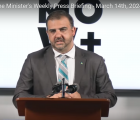
Workmen are busy repairing the roof of a home in Long Island.
LONG ISLAND, The Bahamas – Approximately 60 new one-, two- and three- bedroom homes are on the drawing board for residents in the southeast islands wiped out as a result of Hurricane Joaquin.
Most of the new homes will be constructed in Long Island, the island with the largest population impacted the most in terms of number of homes, and Crooked Island, the island hardest hit in terms of impact of devastation.
According to Jack Thompson, administrator of the Government’s recently- formed National Recovery and Reconstruction Unit (NRRU), the second phase is construction of new homes.
“While the priority is to deal with roof repairs and eventually a lesser extent windows, doors, sheet rock, we will move in short order to new homes. We’ve identified approximately 56 homes in the islands which were totally destroyed or which make no sense putting in capital for. We’ve identified the plans, the persons and the material listing,” he stated.
The priority list includes homes for widowers, single mothers, senior citizens, the disabled and the indigent.
Mr. Thompson summed up the results of a fact-finding visit to Long Island and San Salvador, Sunday November 29, as “extremely productive.”
The administrator headed a delegation to Long Island and San Salvador comprising Captain Stephen Russell, Director of the National Emergency Management Agency (NEMA), and the National Disaster Finance Committee, recently appointed by Prime Minister Perry Christie, which includes Chairman Nat Beneby, Gowan Bowe, Mike Maura, Tracey Knowles and Jean Chalpon. The committee is charged with fundraising; targeting the private community to ensure that systems and processes are in place for the expenditure of the Donation Fund Account.
In addition to inspecting distribution centres, businesses and homes, the delegation got a first-hand look at infrastructure including roads, docks, schools, administration offices and other government buildings. They also chatted with fishermen other members of the business community, the islands’ Administrators and members of the Defence Force stationed in the islands.
“They are looking at the extent of the devastation, to critique and evaluate the processes, make recommendations and to tweak them to have a more effective system.
“We are going to be asking for more funds but people are only inclined to give money if they are satisfied that monies are being spent properly, the supplies are being distributed in an equitable way and given to the persons who are most in need.”
Mr. Thompson said there is no written or prepared text on how to deal with a Category 4 hurricane, but the intention is to ensure that processes are put in place to cause relief as early as possible for the maximum number of residents.
“Our strategy is to do all we can as quickly as possible for the people,” he added.
Infrastructural development is a part of the NRRU’s remit, and scopes of work have already been completed for the airport, road works and government buildings (with the exception of schools). However, Mr. Thompson said his committee plans to look beyond construction and also focus on the fishing community.
“Although you repair homes, if you don’t get people’s economic lives back in order you’re still missing a big point.”
In an effort to keep the public aware of its efforts, the NRRU will make available reports and statements. (BIS Photos/Patrick Hanna)





